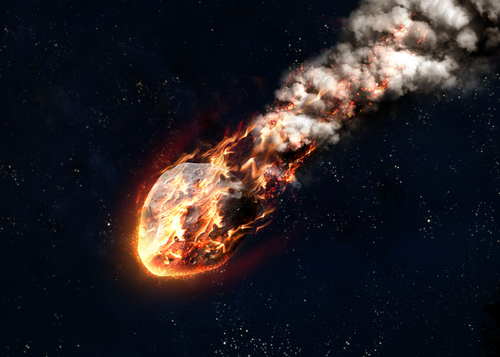
As the world gazes upward, a celestial body known as the ‘devil comet’ has captured the attention of astronomers and stargazers alike with its dramatic and historic series of outbursts. This comet, officially designated 12P/Pons-Brooks, has recently undergone its fourth and most intense eruption, casting a glow comparable to that of a distant galaxy and stirring both awe and scientific curiosity.
The comet’s moniker, ‘devil comet,’ originates from its unique appearance during previous outbursts, which created an illusion of horns, evoking the image of a devilish figure racing through the cosmos. This intriguing phenomenon is not just a visual marvel but also a testament to the dynamic and volatile nature of our universe.
If WW3 or genocide or a holy war or a volcanic eruption in Iceland wasn't wasn't enough for You. There's a "horned" "Devil" comet headed for us that will be seen during a solar eclipse. One article talked about the potential for touching the atmosphere 🫠 https://t.co/L0sUaOMNd2
— Atom Bomb (@BmobMota90) November 11, 2023
The recent outburst of 12P/Pons-Brooks was so significant that it shone with a brilliance exceeding that of the Elliptical Galaxy, located some 600 million light-years away. This extraordinary event was observed by Elliot Herman, an Arizona-based astronomer, who noted the comet’s increased frequency of eruptions, with the latest occurring merely two weeks after the previous one.
Comets are composed of ice, dust, and rocky particles, forming a nucleus surrounded by a gaseous outer layer known as the coma. The ‘devil comet’ is classified as a cryovolcanic comet, exhibiting behavior akin to volcanic activity. However, instead of ejecting molten rock, these comets release gases and ice when they approach the sun and heat up, leading to explosive outbursts that can create distinctive shapes visible from Earth.
Comet 12P/Pons-Brooks experienced its biggest outburst yet on 14 Nov. when it brightened more than 100-fold. Previous major outbursts were on 20 July, 5 Oct. and 1 Nov. The comet has been described as the 'devil comet' due to two "horns" that appeared during previous outbursts. pic.twitter.com/wl7WDGGOGG
— Peter Bond (@PeterBondSpace) November 16, 2023
The ‘devil comet’ has a storied history, first discovered by Jean-Louis Pons in 1812 and later by William Robert Brooks in 1883. It was determined that this comet graces our solar system every 71 years, with at least seven significant outbursts recorded since the 19th century. The year 2023 is proving to be exceptional, potentially matching the historical number of outbursts in a single year.
Astronomers have been closely monitoring the comet’s journey, noting its previous eruptions on July 20, October 5, and November 1. These events have not only provided a stunning visual display but also valuable data for scientists studying the behavior of cometary bodies.
Despite its ominous nickname and explosive behavior, the ‘devil comet’ poses no threat to Earth. It is set to make its closest approach to our planet in June 2024, passing at a safe distance before being gravitationally flung back into the outer reaches of the solar system, not to return until 2095.
This comet’s activity serves as a reminder of the grandeur and mystery of the universe we inhabit. It challenges us to look beyond our earthly concerns and marvel at the cosmic wonders that unfold above us. As we continue to explore and understand these celestial phenomena, we gain not only knowledge but also a greater appreciation for the vastness and beauty of the space that surrounds us.
In conclusion, the ‘devil comet’ provides a spectacular show for those fortunate enough to witness its fiery dance across the night sky. Its recurrent visits to our solar system offer a unique opportunity for observation and study, contributing to our understanding of the ever-changing tapestry of the cosmos.










